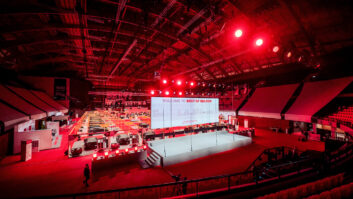
As a company primarily focused on signal management (switching, mixing, interfacing, and format conversion), Kramer doesn’t pick sides when it comes to signal sources and “sinks” (a/k/a displays). We’re more concerned with getting the signals there intact over a variety of connections, which today could mean anything from full−bandwidth HDMI cables to AV−over−IT and fast WiFi.
But we can’t help but observe overarching trends in the AV industry. And one that clearly stands out is a shift away from front projection to direct−view displays, a category that includes everything from flat panel LCD and OLED technology to emissive LED walls, particularly those that use fine−pitch LED arrays.
If you like to attend concerts by popular singers and groups (and who doesn’t−), you may have noticed the extensive use of image magnification (IMAG) in the form of towers of LED cubes, or arrayed as wide walls behind the band (or even both!) It’s hard to miss these stacks, particularly if the concert is outdoors and the sun hasn’t set yet.
Sharp−eyed viewers might also notice that just about every touring act – whether it be U2, Paul McCartney, Blake Shelton, Keith Urban, or a Broadway musical – now uses LED walls as set pieces and IMAG displays. And why not− They’re super bright, scalable, and from a staging standpoint, comparatively easy to assemble and disassemble. At least, more so than flying projectors and screens, the “old school” way it used to be done.
Fact is, LED walls (which primarily use components made in China and are being priced very competitively) have substantially eaten in to the market share of high−brightness projectors. And it’s easy to see why, as there are no lamps to change (or filters) and lenses to fit. You need a bigger image− You simply build a bigger LED wall. No worries about high ambient light levels, not when you’ve got upward of 3,000 nits of brightness to start with.
To achieve that level of brightness with a projector, you’d have to start with well over 30,000 lumens. And that doesn’t even consider the size of the projected image. For those playing at home, let’s assume we want to light up a 10’ x 18’ screen area with the equivalent of 3,000 nits, or 877 foot−Lamberts.
10 x 18 = 180 square feet (x) 877 = 157,860 lumens
Yikes! That’s a LOT of lumens. Even five stacked 30,000 lumens projectors would come up short.
Perhaps a more dramatic example can be found closer to home. As noted in previous commentaries, the free−fall in LCD panel pricing has resulted in bargain−basement deals on televisions, specifically those with Ultra HD (4K) resolution. But you may not have noticed just how low those prices have fallen recently.
It is now possible to purchase 75−inch Ultra HDTVs for less than $1,500, with some Chinese brands falling perilously close to $1,000. This, in turn, has led panel manufacturers to “go big” and bring out even larger panels in the 80” range. Consequently, anyone can buy 82−inch and 85−inch Ultra HD televisions for less than $4,000 – and these sets also support high dynamic range and its associated, wider color space.
It wasn’t that many years ago that a Full HD home theater projector with about 2,000 lumens light output was priced at around $7,000. Add in a screen, brackets, and associated wiring, and you’d be well on your way to $10,000! Given that many home theater installations used screens in the 80−inch to 90−inch range, it’s almost a no−brainer to opt for the self−contained LCD television and do away with the screen, bracket, and a lot of extra wiring.
As you can see, fine−pitch LEDs and super−sized LCD televisions and monitors are nibbling away at projector market share from both ends. And this trend is only going to continue as panel prices and LED pitches continue to drop. So, what market does that leave for projectors−
The answer is any image that requires three−dimensional mapping, like curved walls, spheres, or unusual shapes (trapezoidal, multiple planes). LCD panels can be formed in many ways, but it’s not easy to make them into curved shapes. Their more inexpensive cousins (OLEDs) can be printed onto flexible substrates and warped into all kinds of unusual shapes – even cylinders – but have nowhere near the horsepower of inorganic LED walls. Projectors make more sense here, logistically and financially.
Where projectors fell a bit behind but are catching up is in resolution. The move to 4K started first and foremost with projectors almost 15 years ago, but attention shifted to large LCD displays around 2012. Since then, LCDs and now OLEDs have dominated the discussion, and compared to an 85−inch Ultra HDTV with HDR, a ‘true’ 4K home theater projector is quite an expensive beast. Projectors that use lower−resolution chips and image shifting have now come to the AV marketplace to try and keep pace with the move to 4K.
From our standpoint, all of these trends point toward two things: Faster clock rates and a ton of pixel data moving from point A to point B. Doesn’t matter whether you opt for an LED videowall, a super−large LCD display, or a 4K projector! The increased refresh rates, expanded colour bit depth for HDR, and some new tricks like high frame rates that will result will put greater demands on your signal switching and distribution systems.
Got your back. Our engineers already have their calculators out…







